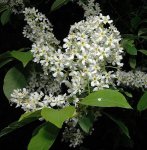Bird cherry
Padus racemosa (Lam.) Gilib. Prunus padus L.
Botanical characteristics. Family rose-colored. A small sapling or shrub with a dark mottled matt bark with a height of up to 10 m. The leaves are regular, elliptical, short-petioled. Very fragrant white flowers are collected in drooping brushes. Blossoms in May-June. Fruits - black sweet astringent stems, ripen in August-September.
Spread. Bird cherry grows in the forest and forest-steppe zones of the European part of our country, in the Caucasus, in Western Siberia and in Central Asia, cultivated as a decorative and medicinal plant.
Used parts of the plant.
Ripe fruits, less often - bark.
In flowers and leaves of bird cherry contains bitter-mixed butter. In the fruits are tannins, organic acids (malic and citric), flavonoids, anthocyanins and glycoside prulaurazin, in leaves a lot of ascorbic acid (up to 200 mg%).
Application.
Used mainly as an astringent. To treat diarrhea of any etiology, use infusion, decoction and kissel from the fruit of bird cherry, use berries in fresh form.
In addition, infusion of berries in the form of lotions is recommended for conjunctivitis and blepharitis; Decoction of the cortex is used as a diaphoretic and diuretic. The bird cherry bark has a pronounced insecticidal effect.
Preparation.
Infusion for internal use: 2 tablespoons of berries are insisted for 6 hours with 0.5 liters of boiling water in a thermos (daily dose).
The broth is cooked in the same proportions.
Fresh berries take 1/2 cup 3 times a day for 20-40 minutes before meals.
Bird cherry has long been used in gardening to combat pests of trees and berries: caterpillars, aphids, beetles and slugs. To do this, prepare infusion of fresh twigs and cherry leaves at the rate of 0.5 kg of raw materials per 10 liters of water. A bird cherry, dropped for a few minutes into the water, kills pathogenic microbes and gives the water a pleasant fragrant taste.




Comments
When commenting on, remember that the content and tone of your message can hurt the feelings of real people, show respect and tolerance to your interlocutors even if you do not share their opinion, your behavior in the conditions of freedom of expression and anonymity provided by the Internet, changes Not only virtual, but also the real world. All comments are hidden from the index, spam is controlled.